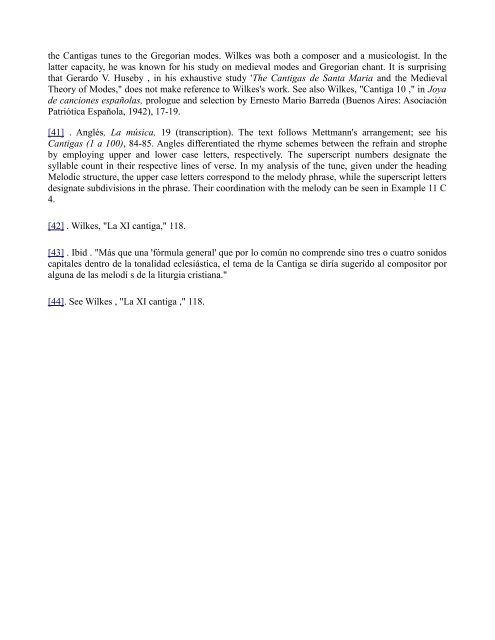Chapter 11 - The Library of Iberian Resources Online
Chapter 11 - The Library of Iberian Resources Online Chapter 11 - The Library of Iberian Resources Online
the Cantigas tunes to the Gregorian modes. Wilkes was both a composer and a musicologist. In the latter capacity, he was known for his study on medieval modes and Gregorian chant. It is surprising that Gerardo V. Huseby , in his exhaustive study 'The Cantigas de Santa Maria and the Medieval Theory of Modes," does not make reference to Wilkes's work. See also Wilkes, "Cantiga 10 ," in Joya de canciones españolas, prologue and selection by Ernesto Mario Barreda (Buenos Aires: Asociación Patriótica Española, 1942), 17-19. [41] . Anglés, La música, 19 (transcription). The text follows Mettmann's arrangement; see his Cantigas (1 a 100), 84-85. Angles differentiated the rhyme schemes between the refrain and strophe by employing upper and lower case letters, respectively. The superscript numbers designate the syllable count in their respective lines of verse. In my analysis of the tune, given under the heading Melodic structure, the upper case letters correspond to the melody phrase, while the superscript letters designate subdivisions in the phrase. Their coordination with the melody can be seen in Example 11 C 4. [42] . Wilkes, "La XI cantiga," 118. [43] . Ibid . "Más que una 'fórmula general' que por lo común no comprende sino tres o cuatro sonidos capitales dentro de la tonalidad eclesiástica, el tema de la Cantiga se diría sugerido al compositor por alguna de las melodí s de la liturgia cristiana." [44]. See Wilkes , "La XI cantiga ," 118.
- Page 1 and 2: THE LIBRARY OF IBERIAN RESOURCES ON
- Page 3: Virgen que hace dulce todo padecer
- Page 6 and 7: [166] Following my publication of 1
- Page 8 and 9: volumes illustrated by exquisite mi
- Page 10 and 11: composition based on a cantiga tune
- Page 12 and 13: (Frankfurt am Main: Hess, 1930), 1:
- Page 14 and 15: Rosa de beldad' e de parecer e Fror
- Page 16 and 17: versification, see Dorothy Clotelle
- Page 18 and 19: Maria MS T.J.1 (Escorial thirteenth
the Cantigas tunes to the Gregorian modes. Wilkes was both a composer and a musicologist. In the<br />
latter capacity, he was known for his study on medieval modes and Gregorian chant. It is surprising<br />
that Gerardo V. Huseby , in his exhaustive study '<strong>The</strong> Cantigas de Santa Maria and the Medieval<br />
<strong>The</strong>ory <strong>of</strong> Modes," does not make reference to Wilkes's work. See also Wilkes, "Cantiga 10 ," in Joya<br />
de canciones españolas, prologue and selection by Ernesto Mario Barreda (Buenos Aires: Asociación<br />
Patriótica Española, 1942), 17-19.<br />
[41] . Anglés, La música, 19 (transcription). <strong>The</strong> text follows Mettmann's arrangement; see his<br />
Cantigas (1 a 100), 84-85. Angles differentiated the rhyme schemes between the refrain and strophe<br />
by employing upper and lower case letters, respectively. <strong>The</strong> superscript numbers designate the<br />
syllable count in their respective lines <strong>of</strong> verse. In my analysis <strong>of</strong> the tune, given under the heading<br />
Melodic structure, the upper case letters correspond to the melody phrase, while the superscript letters<br />
designate subdivisions in the phrase. <strong>The</strong>ir coordination with the melody can be seen in Example <strong>11</strong> C<br />
4.<br />
[42] . Wilkes, "La XI cantiga," <strong>11</strong>8.<br />
[43] . Ibid . "Más que una 'fórmula general' que por lo común no comprende sino tres o cuatro sonidos<br />
capitales dentro de la tonalidad eclesiástica, el tema de la Cantiga se diría sugerido al compositor por<br />
alguna de las melodí s de la liturgia cristiana."<br />
[44]. See Wilkes , "La XI cantiga ," <strong>11</strong>8.



